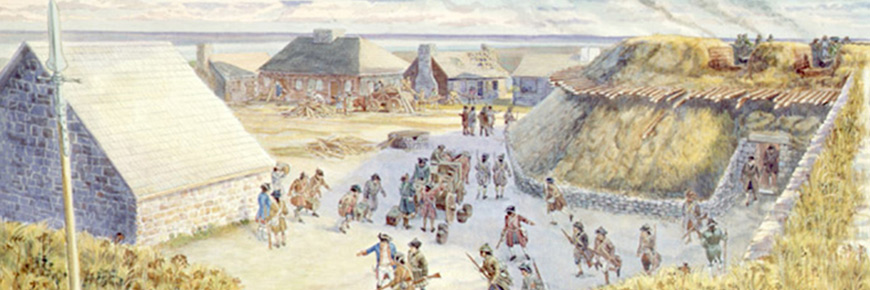
The construction of a fort at Beauséjour
Fort Beauséjour – Fort Cumberland National Historic Site
The British founded Halifax in 1749 to counterbalance the French fortified town at Louisbourg on Île Royale (Cape Breton). It was part of a more aggressive colonial policy. The British demanded that the Acadians take the oath of allegiance, as they had frequently requested off and on since 1713. Such oaths were a common device of European states to secure compliant subjects.
In the growing tension of the period, the Governor of New France sent Charles de Boishébert to erect a fortification on the St. John River in order to protect this important communication link between Beaubassin and Quebec. The French governor also ordered Commandant Pierre La Corne to establish a military presence in the Beaubassin region.
Fort Lawrence
In the spring of 1750, Colonel Charles Lawrence landed with his soldiers on the west side of the village of Beaubassin. They discovered the remains of the Acadian houses which had been burnt at the instigation of the missionary Jean-Louis Le Loutre who, in his efforts to support the cause of France, wanted to force the Acadians to abandon their homes and move across the Missaguash River to French territory. When Lawrence returned in the fall, he ordered his troops to build a fort on the ridge where the Acadian village of Beaubassin had once stood. That wooden British fort was called Fort Lawrence.
French fortifications
The French authorities gave the order to construct a fort at Pointe-à-Beauséjour in November 1750. It was to be built on the ridge overlooking Beaubassin, known today as Cumberland Basin. The new fortification was erected on the west side of the Missaguash River, on the ridge that directly faced Fort Lawrence. According to the wishes of the Governor-General of New France, Jacques Pierre de la Jonquière, it was to be a palisaded fort with provisions and powder stores, barracks, and officers' quarters.
Construction began in April 1751 under the direction of Lieutenant Gaspard-Joseph de Léry. A drawing made during the summer by the engineer Louis Franquet indicated that the work near the Acadian homes was progressing rapidly. That same year, the French put up another fort in the region, on the shores of Baie Verte. It was called Fort Gaspareaux.
Fort Beauséjour
In 1753, the fort was comprised of palisade walls and five-metre high earthwork. It was a pentagon with bastions at the angles that could be equipped with a canon platform. Inside the fort there were four casemates, a powder magazine, barracks and officers' quarters.
These fortifications were designed to provide shelter for a detachment of soldiers and not to withstand a siege of heavy artillery. Since the Baie Française (Bay of Fundy) was controlled by the British navy, supplies for the fort had to be brought in from Baie Verte where boats from Québec and Louisbourg landed.
Next part: Life inside the Fort during the French regimeRelated links
- Long before the Fort: Acadian settlement
- First warfare
- Zone of contention, place of growth
- Life inside the Fort during the French regime
- The Acadians and the fort
- Tensions of the 1750s
- The siege of 1755
- The deportation of the Acadians
- The start of the British occupation
- Settlers from Yorkshire
- The 1776 siege of Fort Cumberland
- Changes to the fort after the second siege
- Creation of the national historic site
- Archeological digs
- Date modified :